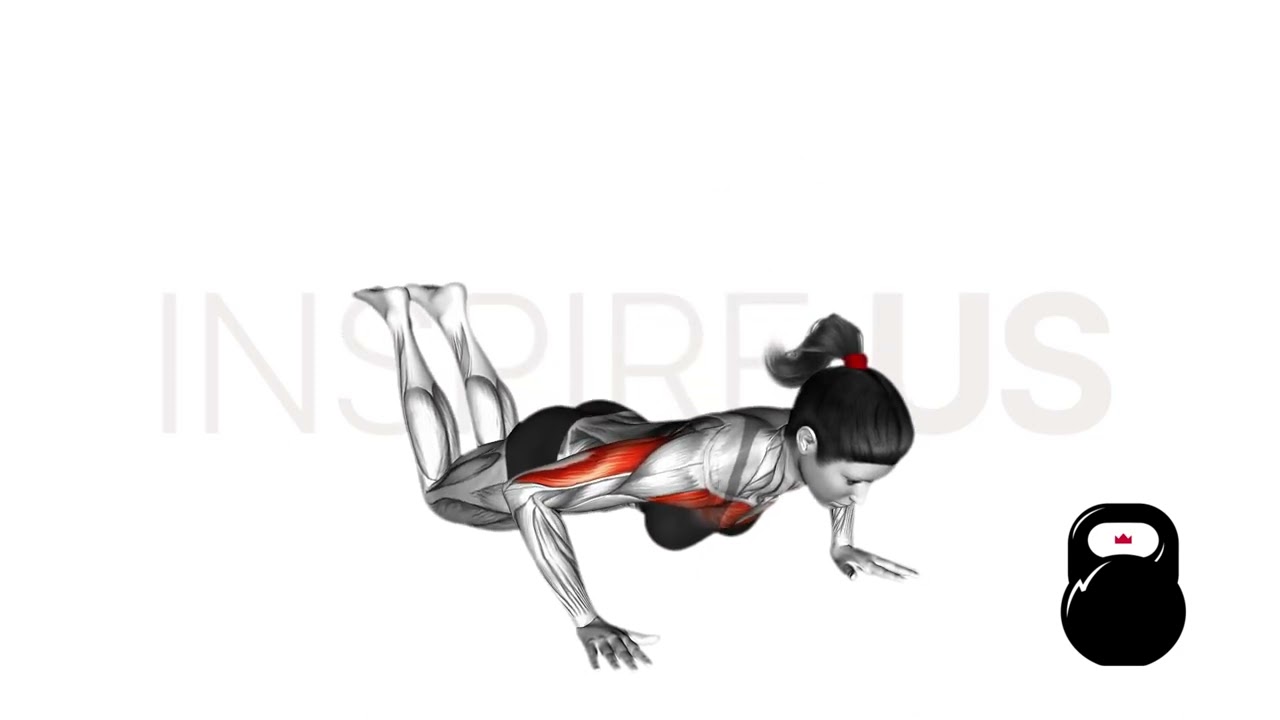Knee Push Ups/Kneeling Push Ups: Benefits, Muscles Worked, and More
From a more technical standpoint, kneeling push-ups are classified as a multi-joint pushing exercise performed for moderate-to-high amounts of volume.

Knee push-ups are most often included into novice calisthenics training programs, but may also see use in cases where more advanced athletes desire further push-up volume without the same level of resistance.
In order to maximize the benefits they receive from this particular kind of modified push-up, calisthenics athletes and other types of bodyweight exercise practitioners will program it as one of the first exercises within the workout - or what is otherwise known as being a primary compound exercise.
Who Should do Knee Push-Ups?
Knee push-ups are significantly easier to do than regular push-ups, and are safe for even the most novice of exercisers. Furthermore, athletes seeking a supplementary exercise to other upper body exercises may also find the knee push-up to be perfect for their needs.
However, if you have a history of elbow, shoulder or wrist injuries, it may be best to first consult your physician prior to attempting knee push-ups.
How to do a Knee Push-Up
To perform a repetition of the knee push-up, the exerciser will enter a half plank position by lying on the floor with their palms and knees supporting their body.
The hands should be set horizontally parallel to the shoulders and slightly wider than shoulder-width apart, with the core contracted and the back in a straight line. The ankles may also be intercrossed if it makes maintaining the stance easier.
From this position, the exerciser will bend at the elbows and contract their chest muscles as they lower their torso towards the floor, stopping just shy of touching it.
Once sufficiently low enough, the exerciser will push through the palms of their hands and extend their elbows, rising back to the starting position in a slow and purposeful manner. At this point, the repetition is considered to be complete.
As a side note, many individuals complain of knee push-ups causing discomfort and bruising along their knees, and as such it may be advisable to use a towel or pillow to cushion the knees as the exercise is being performed.
What Muscles do Kneeling Push-Ups Work?
Kneeling push-ups are known as a compound exercise, meaning that more than a single muscle group is involved in the movement pattern.
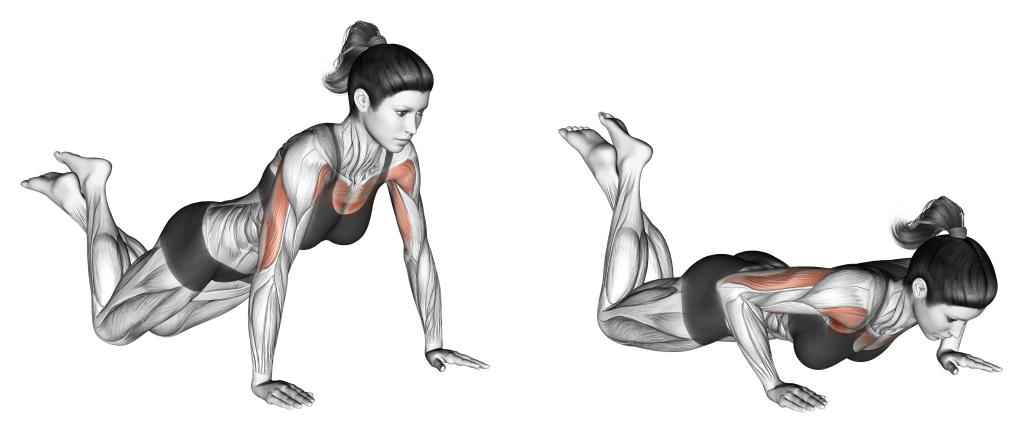
These are divided according to the manner in which they are contracted, with primary and secondary movers being dynamically contracted, and stabilizer muscles solely acting in an isometric capacity.
Primary and Secondary Mover Muscles
Bent knee push-ups primarily target the triceps brachii and pectoral muscles, but will also involve the anterior deltoid head and serratus anterior during certain portions of the range of motion.
Stabilizer Muscles
Despite their reduced involvement, the core musculature and gluteal muscles still play a stabilizing role during the kneeling push-up.
What are the Benefits of Doing Knee Push-Ups?
When done correctly, knee push-ups offer the following benefits.
Perfect Introduction to Push-Up Variation Exercises
Knee push-ups are not only easier than conventional push-ups, but also require considerably less core strength, and will furthermore place far less stress on the joints of the wrists, elbows and shoulders.
This creates a somewhat more forgiving movement with which novices can learn the basics of push-up technique without necessarily increasing their risk of injury.
That being said however, it is still important to focus on form when performing the knee push-up, as injuries can still occur despite its overall safer environment.
Builds Triceps, Chest, and Shoulders Mass
Like many other exercises of its kind, the knee push-up targets the triceps brachii, pectoral muscles and the front-facing section of the deltoids with volume-driven training stimuli - of which is excellent for inducing muscular hypertrophy, building strength and developing muscular endurance.
For a more comprehensive development of the upper body’s push muscles, exercisers may wish to take things a step further by including movements like the bench/triceps dip and the chest dip into their workout plan.
Allows for High Training Volume Without Stabilizer Muscle Limitations
Whether due to the presence of other exercises in the workout or because of underdevelopment, exercisers may find that their conventional push-up performance is limited by the stability of their glutes and core. This can lead to suboptimal training and generally poor form adherence.
Fortunately, stabilizer muscle weakness can be partially avoided by alternating out the regular push-up with the knee push-up, as the latter variation features far less recruitment of said muscles and can help maximize training volume placed on the chest, arms and shoulders.
Excellent for Practicing Upper Body Push-Up Form
For exercisers who have yet to fully master proper push-up technique, the bent knee push-up acts as the perfect tool for practicing the movement pattern without necessarily being limited by joint pressure, muscular fatigue or risk of injury.
This can be taken a step further by seeking out the advice of a professional athletic coach, who may assess the exerciser’s form and give advice as needed.
Common Knee Push-Up Mistakes
Kneeling push-ups are relatively simple to perform, but can be made even more effective by avoiding the following highly common mistakes.
Using Momentum
As is the case with many other exercises, performing knee push-ups without proper control over the body’s own momentum can shift the emphasis of the movement away from the correct muscle groups - if not potentially injure the exerciser as well.
For the safest and most effective knee push-up, each repetition should be performed with as little force derived from anywhere but the chest, triceps and shoulders as possible.
An Insufficient Range of Motion
In order to ensure that the chest muscles are worked properly during each repetition of the knee push-up, exercisers should ensure that a full range of motion is achieved.
This is done by beginning the movement with the arms fully extended, and lowering the chest as close as possible to the ground without actually touching it.
Failing to complete a full range can lead to certain muscles being worked to a lesser extent than intended, and a more ineffective exercise as a whole.
Flaring the Elbows Outwards
Allowing the elbows to flare to the sides can place unneeded stress on the joints of the arms and shoulders, as well as reduce the stability provided to the upper body as a whole.
Exercisers performing the kneeling push-up should seek to keep their elbows aligned with the sides of the torso, and avoid pointing them directly to either side.
Keeping the Shins on the Floor
Although more of a stance issue rather than an execution one, keeping the shins and feet touching the floor during a knee push-up can cause the range of motion to be shortened, if not lead to the lower back rounding from poor mobility as well.
For an easier time performing the knee push-up, it is advisable for exercisers to keep their feet in the air and to balance on their knees instead. If they are having trouble maintaining this position, incline push-ups may act as a more stable substitute exercise.
Progression Exercises and Alternatives of Knee Push-Ups
Because bodyweight exercises can’t quite utilize additional weight for the purposes of progression, exercisers will instead need to perform increasingly more complex movements that utilize the body’s own weight as a greater source of resistance and tension.
For knee push-ups, this generally means either starting your training career with knee push-ups themselves (or incline push-ups), before moving onto more difficult and heavier exercises like the conventional push-up and parallel bar dips.
Keep in mind that the following exercises are arranged according to their relative level of difficulty, with the easiest exercises being placed first.
Knee Push-Up Substitute: Incline Push-Ups
The incline push-up is the most suitable alternative to the knee push-up for the purposes of novice progression, as it is also quite similar to a regular push-up but with the level of intensity greatly reduced.
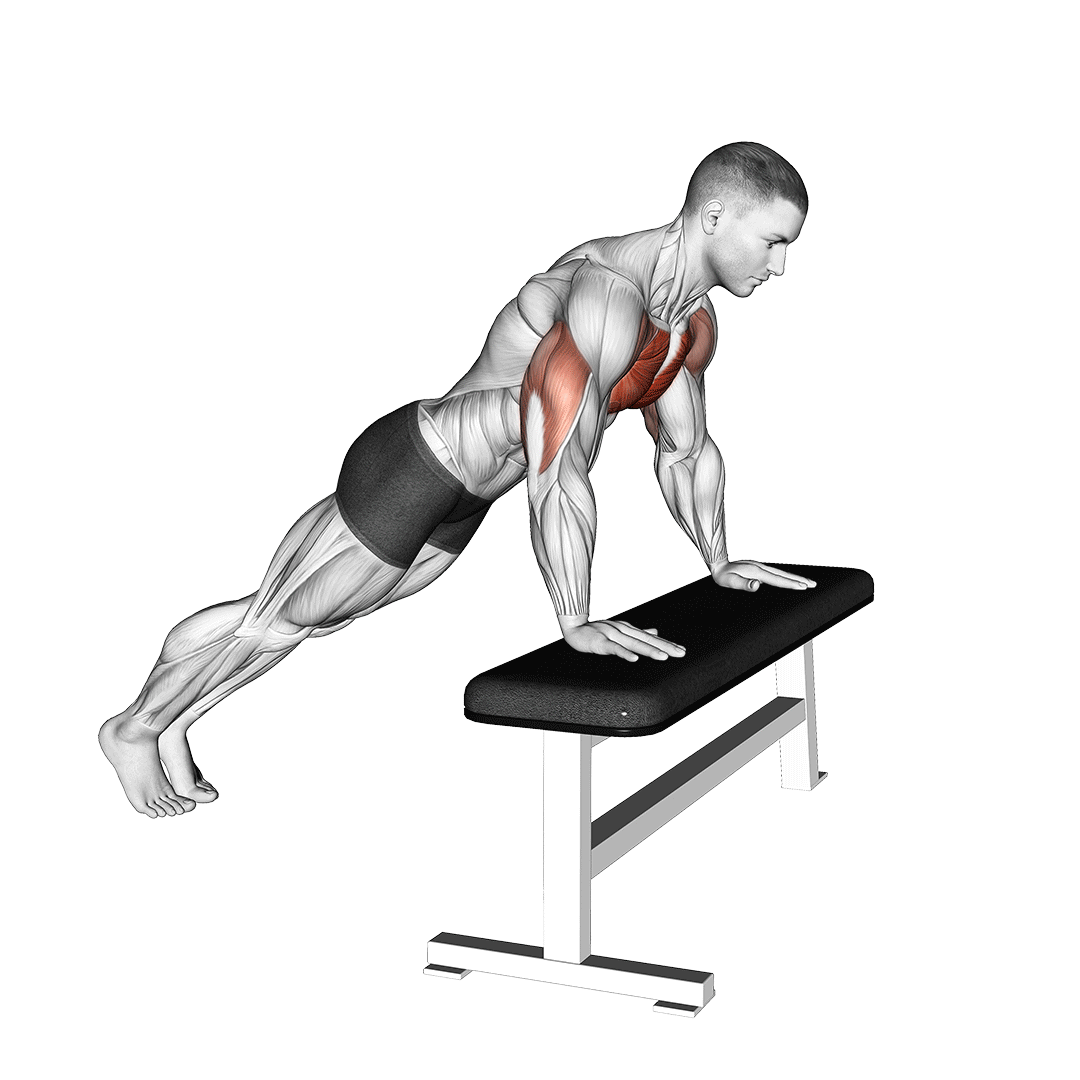
Unlike the kneeling push-up, incline push-ups are performed with the legs fully extended, and the torso elevated over the lower body. This also causes less of the body’s weight to be loaded onto the muscles, and furthermore requires just as little stabilization from the core and glutes.
Kneeling Push-Up Progression: Regular Push-Ups
Once the exerciser is capable of performing approximately 15 knee push-ups (or incline push-ups), they may attempt a full set of regular push-ups.
This will take their muscular development to the next level, and provide significant benefits in terms of athletic capability and exercise technique.
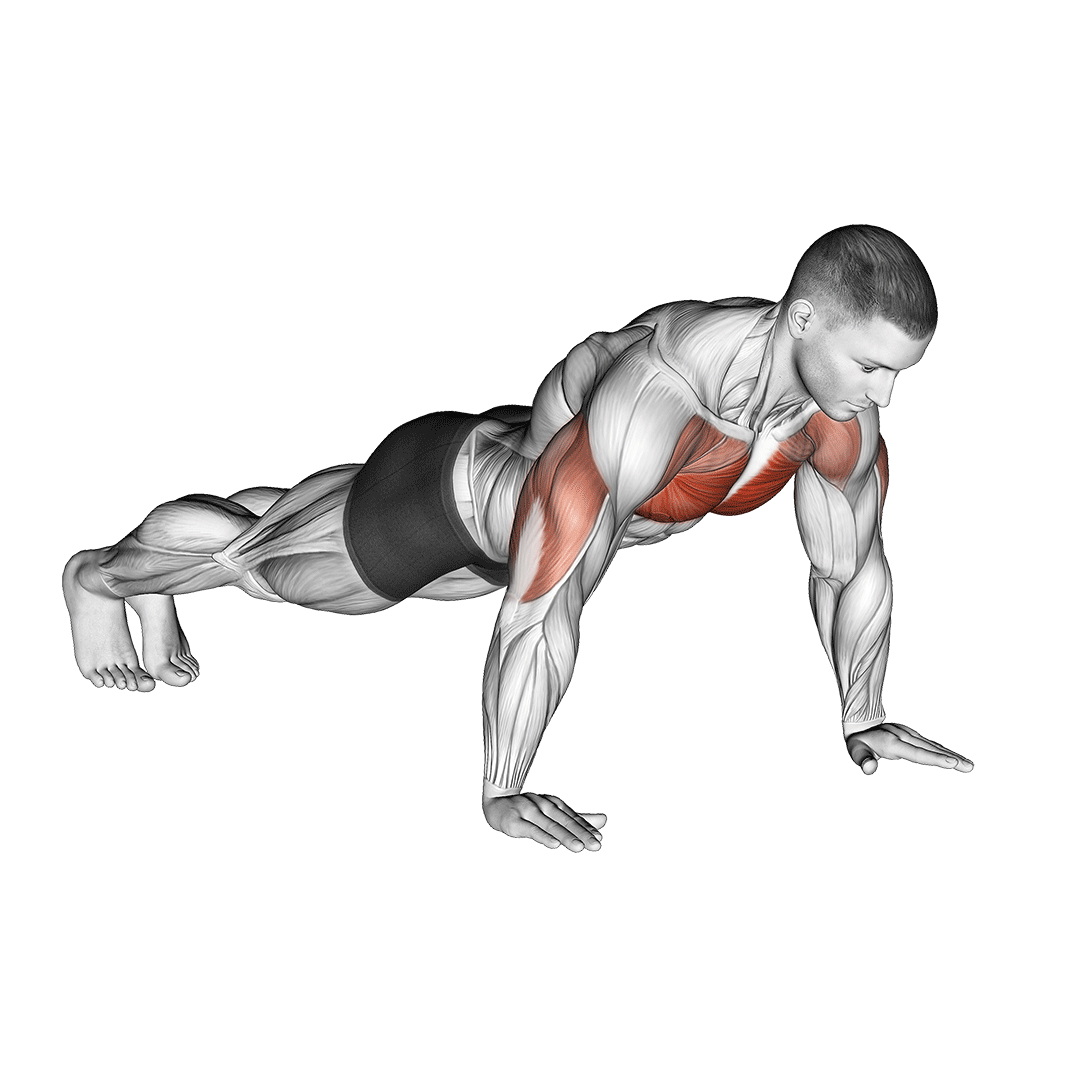
Apart from the obvious differences in stance, conventional push-ups differ from their kneeling counterparts by loading significantly more weight and creating more tension with the muscles of the upper body.
This, in turn, allows for even further progression to more complex exercises like the decline push-up or pike push-up.
Kneeling Push-Up Progression: Chest Dips
Alternatively, rather than progressing to regular push-ups, exercisers wishing to focus even more on their pectoral muscles can perform chest dips instead.
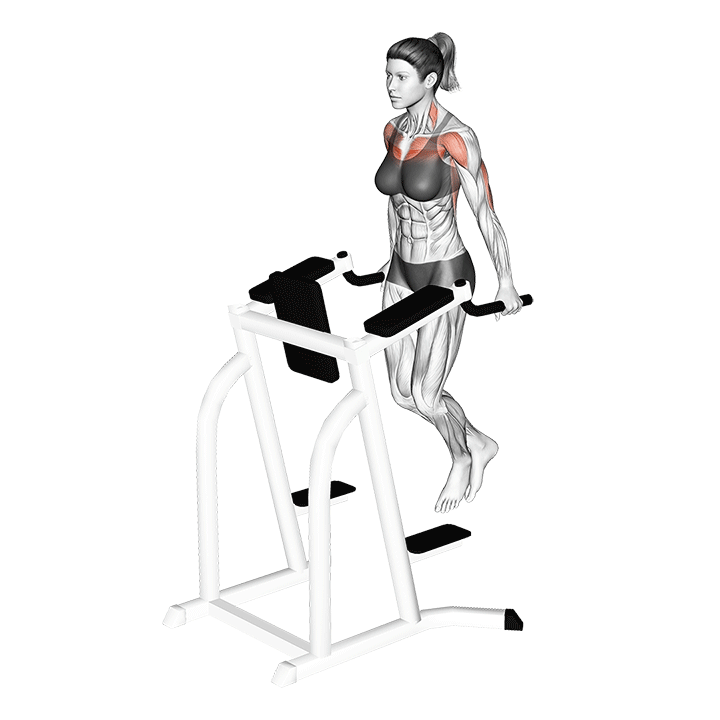
Unlike push-up variations, chest dips are performed with the body suspended between two parallel bars (or rings), and generally require significantly more shoulder stability and upper body strength.
However, in return, exercisers will find that their strength development and athletic capabilities are built far more efficiently than what would be the case with conventional push-ups.
Frequently Asked Questions (FAQ)
Are Knee Push-Ups Good or Bad for You?
Knee push-ups are indeed good for you, as they will not only build upper body muscle tone, but also help familiarize you with the basic tenets of upper body exercise as a whole.
Is the Kneeling Push-Up "Better" Than Regular Push-Ups?
Not necessarily - kneeling push-ups are considered to be both easier and lower-risk than regular push-ups, but are ultimately less effective as a muscle building exercise.
The majority of bodyweight exercisers will begin their journey with kneeling push-ups or a similar kind of movement before progressing onwards to regular push-ups.
How Many Knee Push-Ups is "Good"?
Anywhere between 12-16 knee push-ups is considered enough for progression, whereas over 20 repetitions per set is ideal for athletes using knee push-ups as an accessory exercise.
Final Thoughts
The knee push-up is an undoubtedly useful tool often overlooked because of its association with novice level training. When programmed appropriately, it can help exercisers build muscle mass, practice their push-up technique and even help mitigate the effects of an injury.
If you are unsure of whether your knee push-up form is correct - or if you have any other question related to calisthenics training - seeking out the advice of a professional coach may be your best bet.
References
1. Gottschall, Jinger S., Bryce Hastings, and Zachary Becker. "Muscle Activity Patterns do not Differ Between Push-Up and Bench Press Exercises", Journal of Applied Biomechanics 34, 6 (2018): 442-447, accessed Jun 3, 2023, https://doi.org/10.1123/jab.2017-0063.

